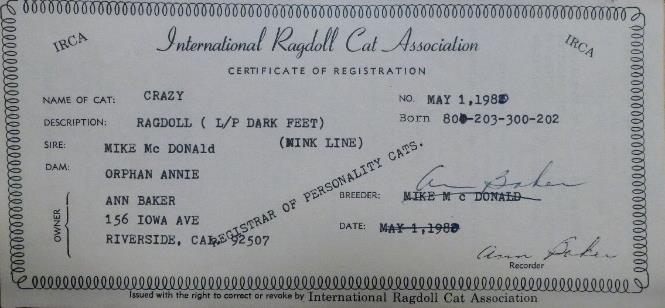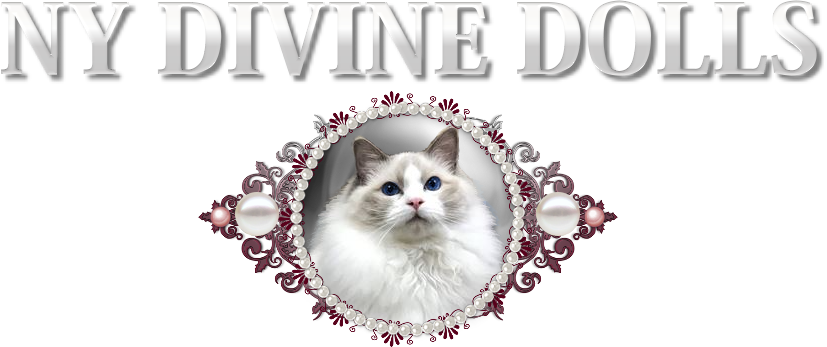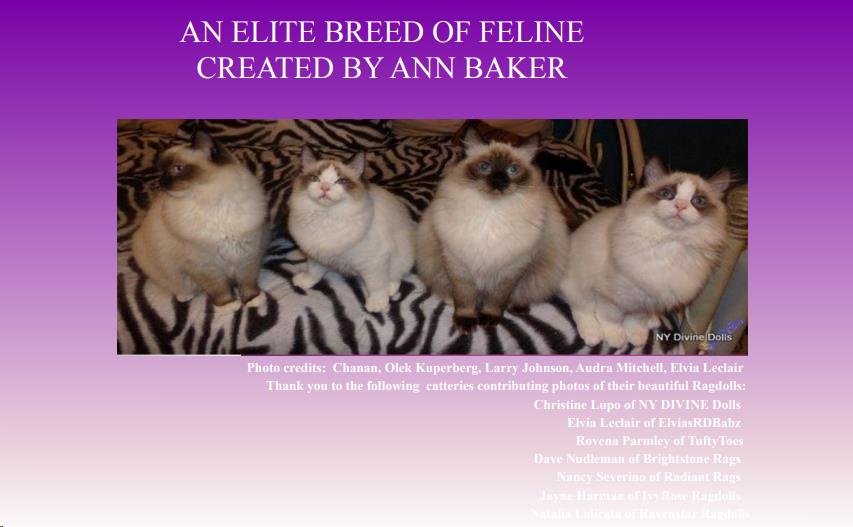
That is a huge debate among Ragdoll breeders! The Ragdoll that most people recognize is a medium haired, blue-eyed kitty with a pale body, dark face, ears, legs and tail and is described as being “pointed.” This coat color pattern is the result of the recessive Siamese gene (cs) and it requires both parents to carry this gene in order to pass it on to their offspring. Ann Baker initially bred Josephine, a solid white cat and mother to all Ragdolls, to create a pointed kitten, along with solid kittens. Josephine had to possess the Siamese pointed gene (C cs) and the father did as well. The father of Daddy Warbucks had to be either a mink (cscb), or a pointed (cscs) cat. Ann Baker, the pioneer and originator of the Ragdoll breed, bred Burmese (the name of the dam), who was a mink, to Daddy Warbucks that continued to produce kittens carrying the Burmese and Siamese pointed genes.
“Original” Ragdolls are defined as those that can be fully traced to Ann Baker’s 3 Original ancestral cats–Josephine, Burmese (Blackie in some databases) which was a female, and Birman (Beauty in some databases) which was a male, as per the Dayton Genetics Card. There are no outcrosses to any other breeds in the lineage of these Ragdolls and they are referred to as having “white pedigrees.” The lines are pure and they are 100% fully traceable to ANN BAKER’s three original ancestral cats with NO outcrosses to other breeds and they are only of the following colors/patterns: Seal, Blue, Chocolate, Lilac in Mitted, Bicolor, or Colorpoint. The Orignal Ragdoll Association in Switzerland maintains the VdOR Database and requires not only five generation pedigrees but DNA proof of parentage and microchips.

In the United States, many breeders use the term, “Fully Traceable” to describe the Ragdoll that is fully traceable to Ann Baker’s foundation cat, Josephine, the mother of all Ragdolls, through the Dayton Genetic Card. Dayton excluded those Ragdoll catteries and their progeny, that remained loyal to Baker and/or restrained via her contracts, from his records (i.e., Blue Mountain, Purple Heather, Vistin, JDs, etc. ). So there are Ragdolls that are actually “fully traceable” that are not acknowledged through Dayton’s early records; however, he did later include a “side line” that recognized Ragdolls from those catteries that could prove their lineage. Those Ragdolls that are considered fully traceable, but technically should be considered 100% Original.
Unfortunately, Charlie Myers who took over the transcribing and upkeep of the RFCI Genetic Database, based on Dayton’s records, did make many human errors that were never corrected; likewise, is the case with PawPeds. Niether can be fully trusted, hence their disclaimer, “The correctness of this pedigree is not guaranteed.” The VdOR is the most credible of the three databases.
“Traditional” Ragdolls are defined by blue eyed pointed American Ragdoll breeders as those bred from the primary Ragdoll pedigree lines – a blue-eyed pointed cat in only the four colors of Seal, Blue, Chocolate, and Lilac transposed over the three recognized patterns of Colorpointed, Mitted, and Bicolor. It is used for these colors that were included in the 1975 Patent by Ann Baker. The blue-eyed pointed Ragdolls have become world renowned because they were highly publicized by Denny and Laura Dayton in the show halls of TICA (The International Cat Association) and CFA (Cat Fancier’s Association). These “Traditional” Ragdolls are not to be confused with 100% Originals. Many breeders in the USA have outcrossed to other breeds and are not cognizant of their cats’ foundation, or lineage, any further than their three to five generation pedigrees. Many believe because their Ragdolls are in only the four colors patented by Baker, that they are “Traditional.” In the field of genetics, a “traditional” cat is a solid.
European breeders have two designations for their Ragdolls, they are either “Original Ragdolls” or “New Color Ragdolls” that have outcrossing in the bloodlines. “Non-Traditional” Ragdolls have outcrossing to other breeds in the blood line as sanctioned by a cat registry and that matches that cat fancy organization’s official Ragdoll standard. “Non-Traditional” Ragdoll Felines consist of the newly recognized colors of CINNAMON, FAWN (Cinnamon’s dilute), RED (Flame) and CREAM (Flame’s dilute). Any cat with Cinnamon, Fawn, Flame, Cream, or Tortie in its pedigree may have an outcross to another breed somewhere along the line, as Red was recognized by TICA in the 1980s and Cinnamon in early 2000. Likewise, any Ragdoll that has a LYNX pattern was either created early in the breed by Ann Baker, or outcrossed somewhere in the line to get the Lynx pattern. One needs only to look at their pedigrees, and/or the foundation in genetic databases such as PawPeds or RFCI, to make the determination from whence it came. In the lynx pattern, the pointed areas of the cat will display distinct barring, or Tabby markings, which are separated by lighter background color. The Lynx markings appear with ANY of the three patterns (bicolor, mitted, and colorpoint) and in all colors. If a Ragdoll female has a Tortie coloring, as well as Lynx markings, she will be identified as a Torbie.
When certificates of registration were transferred from Ann Baker’s IRCA Registry to the TICA Registry, all Ragdolls were reregistered as Ragdolls in one grouping, and not as individuals in the late 1970s and early 80s. Many Solid and Mink Ragdolls were actually registered as Pointed Ragdolls when they were transferred from IRCA to TICA, instead of being specifically registered as a Solid Ragdoll or a Mink Ragdoll. This was most prevalent in the case of the Solid Ragdolls. An examination of IRCA pedigrees transferred to TICA will reveal the very beginning lines of Solid Ragdolls, Mink Ragdolls, Lynx Ragdolls, Smoke and Silver Ragdolls, and yes, even Tortie and Torbie Ragdolls. It was Baker’s intention to include all of the following; Lynx, Red Factor, Chocolate, Lilac, Mink, Solid, and Pointed. Baker, herself, registered these mink and solid cats as RAGDOLLS. Every mink and sepia Ragdoll traces back to Anne Baker’s IRCA registered mink male, Mike McDonald (who may also be found in a tremedous amount of Blue Eyed Pointed Ragdoll lineage), perhaps even further based upon genetics alone. Solid Ragdolls can be traced back to St. Patrick and possibly, Raggedy Ann Geuber.
Denny Dayton and his followers dismissed Ann Baker’s vision of her Ragdoll and made it their mission to establish a small representation of the breed, the Pointed Ragdoll, in the multiple cat associations and show halls. The Pointed Ragdoll is a product of recessive traits, a mutation, that can only be produced by Solid, Mink, or two Pointed Ragdolls–of which are the foundation of the Ragdoll Breed created by Ann Baker. Curt Gehm is another who acquired some of Baker’s Ragdolls, which encompassed the Mink, Solid, and Sepia Ragdolls rejected by Dayton for show. Gehm created a new breed that originated with a limited number of Ann Baker’s cats. Outcrossing was used in the further development of what was coined the “Ragamuffin.” All colors and patterns were accepted for the Ragamuffin and outcrosses were made to Persian, Siberian, Selkirk Longhair, British Longhair, Turkish Angora, and even longhaired domestic cats that have resulted in an extremely different appearance, and Breed Standard, to the Ragdoll.
Mink, Sepia, and Solid pedigreed Ragdolls have been registered since TICA’s inception in 1979 and can be shown in TICA, ironically, only under “New Traits.” This should be changed due to Ragdoll history and genetics. The Ragdoll Breed Committee would bring on an influx of exhibitors into the TICA show halls if they accepted the Mink, Solid, and Sepia Ragdolls for show and altered the current Ragdoll Breed Standard to reflect the following breed groups under Categories. For example: RD as Pointed Ragdolls; RD-M as Mink Ragdolls; RD-Sd as Solid Ragdolls; RD-Sa as Sepia Ragdolls. Thereafter, the Divisions and Colors should be written and delineated. Permissible outcrosses should be NONE. Eye color should be described for the respective breed groups. Everything else, that does not pertain to coloration, should remain the same.
All purebred, registered Mink, Solid, and Sepia Ragdolls should be recognized for championship status for all of the aforementioned reasons. There would be no Pointed Ragdoll without the others. Regardless of their coloration or patterns, all purebred Ragdolls are famous for their extreme loyalty, inquisitiveness, immensely affectionate nature, intelligence, and of course, the Ragdoll flop that invites the coveted belly rubs!
***Click on the slides below for more in depth information replete with graphs, photos, and documents from Ann Baker***

